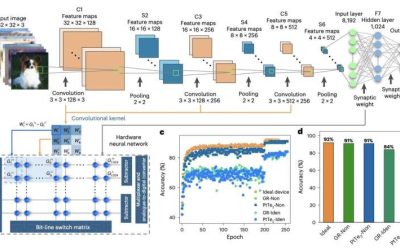While systems that can generate energy from renewable sources are becoming increasingly widespread, it might take a while before these systems fully replace solutions that rely on the burning of fossil fuels. In the meantime, researchers have been trying to develop...
TECHXPLORE
Unique memristor design with analog switching shows promise for high-efficiency neuromorphic computing
The growing use of artificial intelligence (AI)-based models is placing greater demands on the electronics industry, as many of these models require significant storage space and computational power. Engineers worldwide have thus been trying to develop neuromorphic...
Innovative transistor for reconfigurable fuzzy logic hardware shows promise for enhanced edge computing
Edge computing devices, devices located in proximity to the source of data instead of in large data centers, could perform computations locally. This could reduce latency, particularly in real-time applications, as it would minimize the need to transfer data from the...
Aquatic robot’s self-learning optimization enhances underwater object manipulation skills
In recent years, roboticists have introduced robotic systems that can complete missions in various environments, ranging from the ground to underground, aboveground and underwater settings. While several of these robots can grasp and move objects on the ground, the...
Study disproves idea that weather-dependent renewable energy systems are more prone to blackouts
Wind turbines and photovoltaics (PVs) are becoming increasingly widespread worldwide, which could contribute to reducing air pollution caused by fossil fuel emissions. To produce energy, however, these renewable energy solutions rely on specific weather conditions...
Computational framework simplifies synthesized motions for human characters in 3D environments
Artificial intelligence (AI) systems have become increasingly better at synthesizing images and videos showing humans, animals and objects. The automated generation of videos in which human characters engage in specific activities could have various valuable...
Alternative model can identify fake news by processing both textual and visual data
The advent of the internet has changed the way people access and share information, making it easier for malicious individuals to spread biased, unreliable or false news. Recent technological advances, including artificial intelligence (AI) models that can generate...
Study conceptualizes GenAI-driven Industry 6.0 with a successful swarm demonstration
Since the industrial revolution, manufacturing processes have continuously evolved in alignment with technological advances. Recent innovations, particularly in the field of robotics, 3D printing and machine learning, could soon facilitate further change, potentially...
Simplified octopus-inspired swimming robot with soft asymmetric arms can replicate swimming patterns
Researchers at the National University of Singapore have developed a new robot inspired by one of the most intelligent aquatic animals on Earth: the octopus. This robot, presented in a paper published on the arXiv pre-print server, could be used...
Novel liquid acoustic sensor mimics whale melon to recognize voices in noisy environments
In recent years, engineers have developed a wide range of increasingly sophisticated sensors for robotic, portable, wearable and even implantable monitoring. The data collected by these sensors can then be analyzed using state-of-the-art machine learning, allowing...










